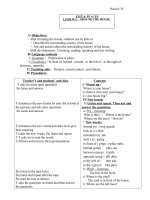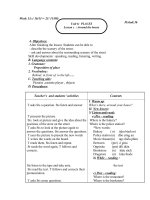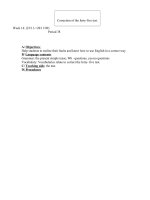Bài giảng tiếng Anh - Phần 3 pptx
Bạn đang xem bản rút gọn của tài liệu. Xem và tải ngay bản đầy đủ của tài liệu tại đây (138.4 KB, 8 trang )
Week 14: (23/11->28/11/09)
Period 38
A/ Objectives :
Help students to realize their faults and know how to use English in a correct way
B/ Language contents:
Grammar: the present simple tense, Wh –questions, yes-no questions
Vocabulary: Vocabularies relate to correct the forty- five test.
C/ Teaching aids: the test.
D/ Procedures
Correction of the forty-five test.
Teacher’s and students’ activities
Contents
T asks Sts some questions
T asks Sts to choose the best answers
T follows and corrects
T asks Sts to supply the correct form of
the verb in the bracket
T follows and corrects
Sts read the passage again and check T
or F
Sts read the passage again and answer
the questions
T follows and corrects if necessary.
T asks Sts to write the questions
T follows and corrects
I/ Warm up:
How did you do this test?
Have you ever been any mistakes?
II/ New lesson: The correction of the
test. Task 1
A. Language focus:
I. Choose the best answer (2m)
Tổng số 2 điểm gồm 8 câu. Mỗi
câu đúng 0,25 điểm
1- b 2-c 3-a 4-b
5-c 6-b 7-d 8-a
II. Supply the correct form of the verb in
the bracket: (3m)
Tổng số 3 điểm gồm 6 câu. . Mỗi
câu đúng 0,5 điểm
1. My sister is a teacher.
2. She doesn’t do the
housework after school.
3. Does he play soccer in the
afternoon?
4. Mr Tuan and Mr Nam are
engineers.
5. They have lunch at half
past eleven.
6. We aren’t doctors.
B. Reading :
I. Answer True(T) or False (F) :
(1m)
gồm 4 câu Mỗi câu đúng 0,25 điểm
1. F 2. F 3. T 4. T
* II. Answer the questions: (2m)
gồm 4 câu Mỗi câu đúng 0,5 điểm
1. Is Thu’s school in the city?
-> No, it isn’t
2. How many teachers are there in her
school?
-> There are forty teachers.
3. Does she go to school at half past
six?
-> Yes, she does.
4. What time does she go to bed?
-> She goes to bed at half past nine.
C. Writing:
Write the questions: (2m)
1. What time does she get up?
She gets up at half past five.
2. When do you have English?
I have English on Monday, Friday
and Saturday.
3. How are you?
Period 39
A. Objectives:
After finishing the lesson. Students can be able to:
- describe about the house and the surrounding scenery.
- ask and answer about the surrounding scenery of the house.
Skill developments : speaking, reading, listening, writing.
B. Language contents:
1. Grammar:
Indefinite articles a/ an ; any
2. Vocabulary: letter, vegetable garden, any…
C. Teaching aids:
Pictures, cassette player, objects
D. Procedures:
Teacher’s and students’ activities Contents
T asks Sts to match the groups of words
with the pictures
T follows and corrects
T asks Sts some questions
T introduces the situation of the lesson
T presents the picture and asks Sts some
questions
Sts look at the pictures and answer
T read the words , Sts listen and repeat
Sts read them, T follows
Before reading the dialogue, Sts guess and
answer the questions “ true or false”
I. Warm up:
In front of to the left of
Behind to the right of
Ex: S1: Where’s the tree?
S2: It’s [next to] the house
Is your house big or small?
What are there around your house?
II. New lesson:
1/ Listen. Then practice with a
partner:
a. Pre- listening
What is this?
How many students are there?
Is Hoa’s house big or small?
Is it old or new?
What are there around her house?
* New words:
Any ( pro) một người nào đó, một vật
nào đó
Old (adj) : cũ # new (adj) mới
Unit 7: YOUR HOUSE
Lesson A: Is your house big?
Sts answer and change the answers with
their friends.
Sts write the answers on the board. T
follows but not correct their faults
Sts listen to the tape
T asks Sts to read the dialogue. T follows
and corrects
Then T asks Sts to do the answers true or
false again. T corrects and gives the answers
T explains how to do this part
Sts practice asking and answering the
questions
T follows and corrects their faults
T gives some examples and explains how to
do part 3.
Sts look at the pictures and practice asking
and answering
T follows and corrects their faults.
T gives and explains the examples.
Sts practice asking and answering.
T follows and corrects their faults
Sts look at three pictures in A4. Then listen
to the tape and choose the house they hear.
Sts change the answers with their friends.
T asks Sts to give their answers.
Sts listen to the tape again and T gives the
correct answers
T reminds the “ yes / no “ question with
TOBE
Teacher asks students to complete the
sentences.
*Answer “True or False”
a. Hoa’s house is small.
b. Hoa’s house is new
c. There are flowers in front of her house
b. While –listening :
The dialogue
a. T
b. F
c. T
c. Post-listening:
Now work with a partner. Ask questions
about their house.
Ex: Is your house big?
Yes, it is
3/ Practice with a partner:
a) Example:
What is that ? It is a hotel
What are those? They’re stores.
Picture 2: What are those? They’re
flowers
Picture 3: What is that? It is a bank
Picture 4: What is that? It is a super
market
Picture 5: What is that? It is a restaurant
Picture 6: What is that? It is a hospital
Picture 7: What is that? It is a post office
Picture 8: What is that? It is a police
station
b) Example:
Is there a lake near your house?
Yes, there is.
Are there any trees near your house?
No, there aren’t.
5/ Listen to this description. Which
house is it?
There are some mountains behind the
house. There are some trees to the right
of the house. There’s a lake to the left of
the house
III/. Consolidation ( remember)
Is it… ? Yes, it is / No, it isn’t
Is there a … ? Yes, there is / No, there
Teacher follows and corrects their faults.
Students prepare the new lesson and do
exercises.
isn’t
Are there any ?
Yes, there are / No, there aren’t
* Exercise :
Complete the sentences using Is there
/Are there
a………… . a yard in front of the
house?
b…………… a park near your house?
c……………. any flowers in the yard?
d…………… trees behind the house?
IV. Homework :
Unit 7 (cont )Lesson B: Town or Country
(1)
Exercise 1->5 ( page 66, 67)
Period:40
A. Objectives:
After finishing the lesson. Students can be able to describe the scenery of the quarter.
Skill developments: speaking, reading, listening, writing.
B. Language contents:
1. Grammar:
Indefinite a/an
There is…………….; there are………………
2. Vocabulary:
Quite, clinic, market, zoo, supermarket, noisy …
C. Teaching aids:
Pictures ,cassette player , objects
D. Procedures:
Teacher’s and students’ activities Contents
Unit7: YOUR HOUSE
Lesson B: Town or Country?
T uses the picture and asks one St to
describe it. Then T asks St some
questions
T asks Sts some questions
Sts answer them
T asks Sts some questions
Sts look at the pictures and answer
T introduces the situation of the lesson
T uses the picture to introduce the new words.
T writes the words on the board.
T reads them, Sts listen and repeat.
Sts read the words again, T follows and
corrects.
Sts listen to the tape
Before reading the text, Sts look at the
answers and take note
T asks Sts to read the text in silence then
choosing the correct answers
Sts change the answers with their friends.
Sts practice asking and answering the
questions
Sts write the answers on the board.
T follows and corrects their faults
T asks Sts to look at and describe the picture
T asks Sts a question.
Sts listen and answer.
T reminds the yes /no question
T asks Sts some questions.
I. Warm up:
Where are the tall trees?
Where is the vegetable garden?
Is your house in the country or in the
city?
What’s there, around your house?
II. New lesson:
1/ Listen and read. Then choose the
correct answers:
a. Pre- reading
Is it in town or in the country?
What are there near an apartment?
• New words :
Apartment (n) căn hộ
Town (n) thành thị
Supermarket (n) siêu thị
Post office (n) bưu điện
Clinic (n) phòng khám
Market (n) chợ
Zoo (n) sở thú
Noisy (a) # quiet (a) ồn ào # yên tỉnh
b. While – reading :
The text
*Choose the correct questions
a. Does Ba live in town?
-> Yes, he does.
b. -> No, he doesn’t
c. -> Yes, it is.
d > No, she doesn’t
e > No, there aren’t
f -> Yes, it is
c. Post-reading:
What are there around the apartment?
III/. Consolidation ( remember)
Do you live in town?
No, I live in the country.
Does he live in town?
No, He lives in the country
Aren’t = are + not
* Exercise :Answer the questions:
1.Where is your house?
2.Where do you live?
3.Is your house in the city?
4. Do you live in an apartment?
T follows and corrects their faults.
Sts learn by heart the lesson.
Sts prepare the new lesson and the exercise
IV. Homework :
Learning by heart the lesson
Unit 7: (cont) Lesson B : (2, 3, 4)
Exercise : 1,2(page 68)
* Experience:
Signature(21/11/09)
Trương Ngọc Điệp









